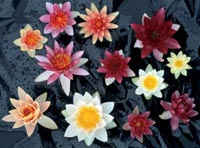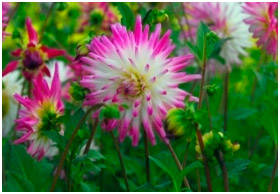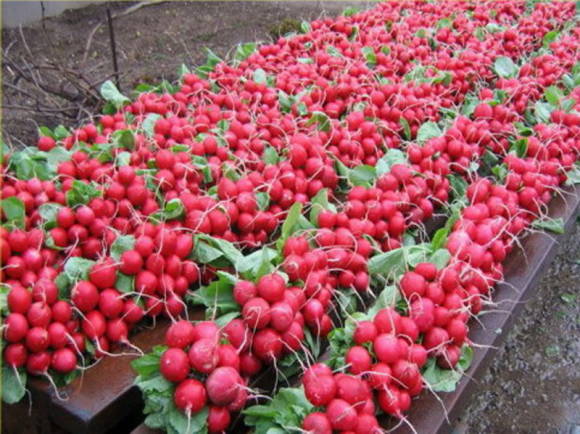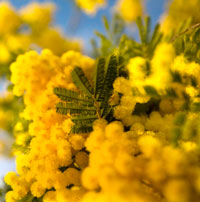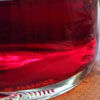The natural sweetener carob has recently appeared on the list of our dietary products, although its source was well known to Russians until 1917 under the name Tsaregradsky pod. Carob is a flour made from the fruit of the carob, known to botanists as foliar ceratonia(Ceratoniasiliqua), and to the inhabitants - like John's bread, carat tree, locust, Mediterranean acacia, acrid tree.

Diamond facets of carob
Genus name Ceratonia comes from the Greek word "horn" - ceras, and the name of the species siliqua translated from Latin means "pod, bob". Ceratonia gained universal fame thanks to its seeds, which have long been used as a measure of the weight of precious stones. The word carat comes from the name of the genus. The ancient origin of the plant is confirmed by the Jerusalem Talmud and the Torah, where the fruits of the carob tree are mentioned. The poor were slaughtered with its fruits, they also fed the cattle. Ceratonia beans, according to the New Testament, ate the prodigal son and John the Baptist in their wanderings. Hence, another of the names of the carob tree appeared - John's bread. Some peoples consider this tree to be sacred.
The carob tree has been familiar to people since biblical times, but still left us with a number of unresolved questions. Botanists will not come to a consensus in any way as to which family to classify the pod Ceratonia (Ceratoniasiliqua), which is an oligotypic genus. Belonging to oligotypic genera (including a small number of species, in this case only 2) indicates a very ancient origin. Most botanists attribute ceratonia follicle to the legume family, but some experts believe that it should be attributed to the Caesalpiniaceae family. (Caesalpinioideae). Morphological proximity allows us to consider the Cezalpiniev family as a subfamily of Legumes.
The carob tree has been cultivated in the Mediterranean since biblical times, and for such a long time it even managed to run wild there again. Now ceratonia is also grown in India, Argentina, Brazil, northern Africa, the Middle East and a number of Central American countries. In the Russian Federation, you can meet the carob tree on the coast of the Caucasus in Abkhazia (between Gagra and Sukhumi).
 |  |
The best fruits of ceratonia come from Cyprus and the Levant, followed by Spain and Italy. Until 1917, Russia imported beans annually in the amount of 400 thousand rubles, selling them at the prices of a delicacy called Tsaregrad pod or sweet horn. What was the reason for such popularity? The delicacy had an undeniable commodity advantage: the fruits did not require additional processing and were stored for a long time. Dried pods can be eaten: they have a sweetish taste similar to dried honey dough.
Another unusual fact that allows some peoples to classify pod Ceratonia as a sacred plant: in natural conditions, parasites never settle on it.
Botanical portrait
Let's take a closer look at this plant.
A carob tree can grow as a large bush or a short tree about 10 m high with a wide hemispherical crown. Ceratonia is photophilous and grows well at an altitude of 400-1600 m above sea level on rocky soils, strengthening the slopes with roots that threaten with rockfalls. The change of seasons does not affect the appearance of this evergreen tree, it grows slowly, but it can live for several centuries. The trunk of the tree is thick, sturdy and durable, with brown or dark gray rough bark. The crown is supported by strong, often twisted and intertwined branches and branches. Since the leaves do not fall off, it is not possible to see this tangled "hair" from the side.
The leaves of the plant are dark green, with a lighter seamy side, dense, leathery, pinnate, up to 20 cm long, up to 7 cm wide, with 7-11 leaves.
The tree blooms in the 5-7th year of life and from 8-10 years old begins to actively bear fruit.
Flowers collected in a brush are small, inconspicuous, with a cream or pink cup, which quickly falls off, without a corolla. The plant is dioecious, but sometimes male flowers are found on female trees. Female flowers with 1 pistil, male flowers with 5 stamens, emitting a specific aroma, similar to the smell of semen. The aroma is due to the production of polyamines, which are also contained in semen. This is how the plant attracts insects for pollination.

In different regions, flowering begins at different times of the year: from February to October. In the Mediterranean, ceratonia is the only tree that blooms in autumn, in October. After 3-4 months, fruits are formed - non-opening beans. Green juicy beans grow and ripen for about a year, acquiring brown color as they ripen and reaching impressive sizes: 10-25 cm long, 2-4 cm wide and 0.5-1 cm thick.
The carob tree bears fruit for 80-100 years, the annual yield can reach 200 kg. The juicy pulp of beans contains up to 50% sugars, which determines their use in the confectionery industry. Along the entire length of the pod, between the thick fleshy walls, there are 8-12 cells with small round seeds. Fresh fruits have a strong astringent taste. The beans are removed and laid out in the sun to ripen. The pods taste sweet as they dry. The dried pulp of the fruit is ground into a powder, which is called carob.

Chemical composition and useful properties
The content of proteins, fats and carbohydrates in carob beans is 8: 4: 88% or 4.62: 0.65: 49.08 g per 100 g of product, respectively. The energy value of the fruits is 222 kcal / 100 g. Beans in large quantities contain such chemical elements as K - 827 mg, Ca - 348 mg, Mg - 54 mg, P - 79 mg, Na - 35 mg, as well as trace elements: Fe - 2.9 mg, Mn - 0.5 mg, Zn - 0.9 mg, Cu - 0.6 mg, Se - 0.05 mg and vitamins A, group B, and D. High content of potassium, iron and magnesium ensures the normal functioning of the cardiovascular system, calcium - the prevention of osteoporosis, and zinc - an increase in potency. The pods also contain pectin, gum, tannins, and antioxidants. Another characteristic feature of the fruits of ceratonia is the complete absence of gluten, which is important for celiac patients. All these parameters make it possible to classify carob fruits as dietary products, and dried beans powder - carob - can be actively used in healthy diets.

Carob seeds are worthy of special attention. They added another page to the glorious history of the carob tree. The invariability of the weight of carob seeds (0.2 g) has been tested by jewelers for many centuries, because they were used as a measure of the weight of jewelry, calling the seed a carat. This is where another name for this popular plant originates: the carat tree.
In fact, as studies have shown, the weight of seeds varies within 5% (as in most seeds), but a person does not distinguish a difference of up to 5%, especially with such a low weight. Round smooth seeds in a pod are very hard, like pebbles, it is almost impossible to bite through them, which justifies the origin of the genus name from the Greek word keras - horn. The hardness of the seeds is due to the content in them of a large amount of galactomannans (up to 90%).
In ancient Rome, the measure of weight, known to us as a carat, was called "silicwa" according to the specific name of the plant - siliqua, and a gold coin weighing 24 carats was called "solid" and weighed 4.5 g. Based on this, the carat was taken as a unit of measurement of the purity of the substance: 1/24 of the fraction of pure substance from the total mass of the mixture is denoted by the letter K. If we see on gold the product has a stamp of 24K (carat), which means that we have 100% gold in front of us. In Russia, the following gold samples are accepted: 583 corresponds to 14K, 375 is the minimum standard for gold purity and corresponds to 9K.
Over the centuries-old history of using the carob tree, mankind has managed to study many of its useful properties. The fruits are widely used for the production of flour, gum and syrup.
Flour obtained from the pulp of the mesocarp of the fruit. It is commonly known as carob. For the production of flour, ripe fruits are taken, seeds are removed and the ends of the pods, which can be bitter, are cut off. The pods are air dried. The powder from unroasted dried pods is beige in color, sweet taste with a nutty flavor. It is used as a sweetener in the confectionery industry. Fine flour from pods fried for 10-12 minutes at a temperature of + 205 ° С, darker and less sweet, with a slight bitterness. It is used as a substitute for cocoa powder, from which it is distinguished by its sweet taste and complete absence of caffeine. To get a cup of a healthy drink instead of cocoa, it is enough to pour one teaspoon of powder with hot water, while the dose of sugar should be reduced.
Carob is also used in the confectionery industry to make candies, sweet pasta, and bars. By analogy with chocolate, sweet bars are called "carbolat". A sweet cream based on syrup and powdered milk - Carob cream - has also gained popularity.
The main advantage of carob is the absence of a number of substances in its composition.
- The fat content in carob is minimal, which increases the shelf life, however, the fruits contain linolenic and oleic acids, which are not produced by the human body.
- Does not contain caffeine and theobromine, which are neurostimulants found in cocoa beans, avoiding the dependence on chocolate consumption that builds up over time.
- The complete absence of glucose makes carob suitable for dietary nutrition of hypertensive and diabetics. However, in this case, its calorie content should be taken into account.
- Does not contain oxalic acid, which provokes the development of kidney and urolithiasis and prevents the absorption of zinc and potassium, worsening the condition of the skin.
- Does not contain phenylethylamine, a neurotransmitter that can trigger migraines.
Carob products are widely sold in stores in Turkey, Cyprus, Portugal, Italy, Sardinia and Malta.
The fruits of ceratonia have long been used as a folk remedy. Herbalists use the enveloping properties of the pectin and gum found in the beans.
Pectin and gum are food stabilizers. In the notorious European system of codification of food additives, pectin is assigned the code E440. There are no restrictions and contraindications to its use. Pectin is widely used as a thickener, has coagulating, antioxidant and bactericidal properties. Coagulating properties allow to lower blood cholesterol levels, adsorb and remove heavy metals, radionuclides and toxic substances from the body. Pectins from fruits of ceratonia are low esterified and can gel without the use of acid.
In the conditions of central Russia, the main source of pectin is cheap beets, so there is no need to extract it from exotic acrid beans for us.
To receive gum crushed seed endosperm is used. Locust bean gum has its own code in the codification system for food additives - E410, it is a yellowish-white powder, consisting of neutral polysaccharides, dissolves in water at a temperature of + 85 ° C. There are three types of gums: guar gum E 412 (from Guar, or Tsiamopsis quadruped), xanthan gum E415 and locust bean gum E410. Gum formation occurs only in perennial plants, mainly shrubs and trees; to a lesser extent, this process is inherent in perennial herbaceous plants with woody stem and root.The addition of gum, which is a natural thickener, turns all liquids into a gel. The main advantage of the gum is that it does not react in the body and is excreted unchanged. Due to its enveloping properties, gum is the basic component of all drugs for the treatment of a sore throat and gastrointestinal tract. It is included in the Pharmacopoeia of Kazakhstan and Belarus, but is not included in the State Pharmacopoeia of the Russian Federation.
Locust bean gum is soluble only when heated, its distinctive feature is synergism with xanthan and other hydrocolloids.
The gum is used as a stabilizer in the food industry and cosmetology. Every day we meet her at our table, because as a thickener, it is found in many products, such as processed cheeses, sour cream, curds, yoghurts, ice cream, canned vegetables and fruit, ketchups, sauces and many others.

The beans are used to make refreshing drinks, compotes and liqueurs. Bean juice is used to make syrup and alcohol... The syrup is made by boiling finely chopped beans, followed by evaporation. It is used as a sweetener in the food industry, as well as a drug for upper respiratory tract diseases, diarrhea, poisoning, nervous disorders and sleep disorders. It is an effective remedy for shortness of breath in allergies. Due to the presence of tannins - tanning and astringent substances - the syrup is very effective for diarrhea in young children.
The syrup contains 3 times more calcium than milk, it is useful for the prevention of osteoporosis. In addition, it contains plant antioxidants - polyphenols, and does not contain theobromine and caffeine. There are no contraindications to the use of syrup.
The syrup should not be used with milk, because this can cause diarrhea, nausea, and flatulence.
Ceratonia as a potted plant
Having become familiar with the many useful properties of ceratonia, we can multiply our collection of houseplants with carat wood. As a pot culture, ceratonia is quite hardy and unpretentious. However, at home, the plant loses its invulnerability to parasites and can be easily affected by mealybugs or spider mites. In the summer, the plant requires frequent watering, which is limited during the cold season. During the rest period, the temperature should not exceed + 12 ... + 15 ° С, in summer the temperature will be optimal around + 25 ° С. In spring and autumn, it is necessary to prune, controlling the formation of the crown of the bush. Once every 2-3 years, the plant is transplanted by transshipment.
It should not be forgotten that the carob tree is a dioecious plant, and those who want to get a harvest will have to grow two bushes at once or work hard to find extremely rare bisexual plants. Obtaining fruits is possible only in greenhouse conditions with optimal illumination parameters; at home, the plant is unlikely to bear fruit.
For many centuries, people have been cultivating the carob tree and using its many beneficial properties. Now, at the peak of new technologies and materials, we should remember the many merits of the carob tree to mankind and return it to its worthy glory and application.



